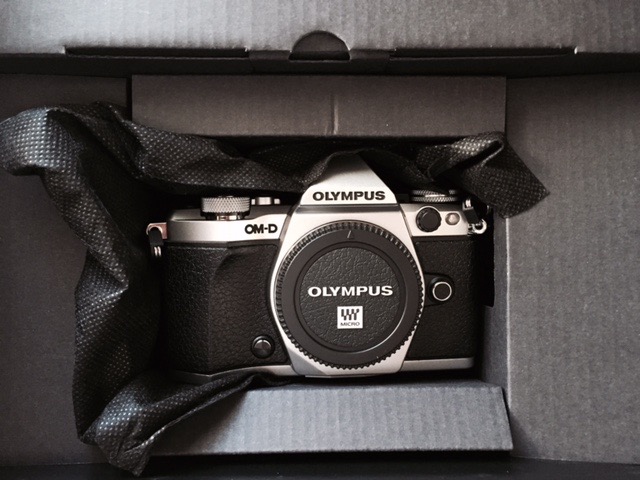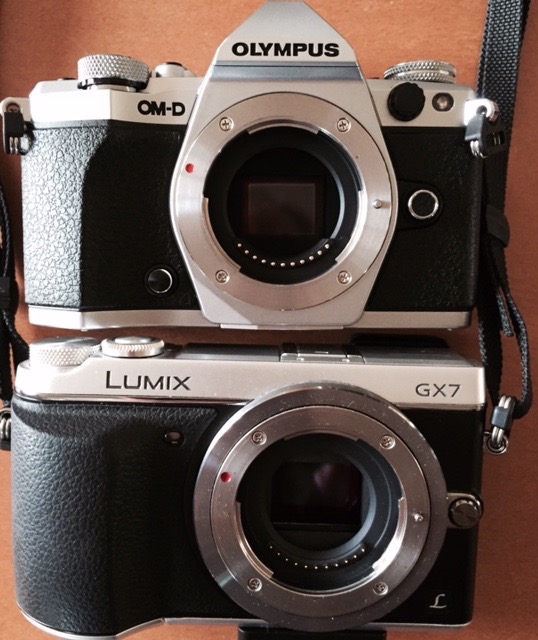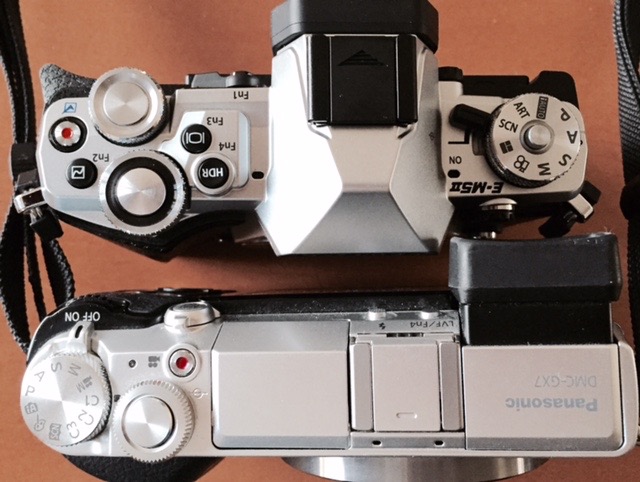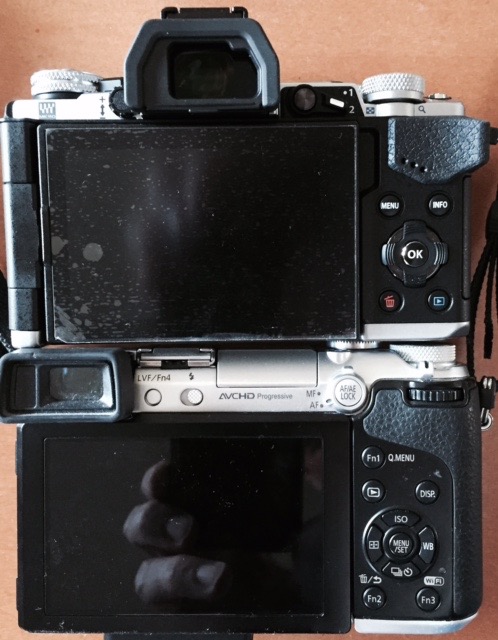A quart in a pint pot.

I just took delivery of my Mark II Olympus MFT body, my first non-Panny MFT, having been happy with the Panny G1 (superb and innovative), G3, two GX7s and an LX100 (my son’s, actually). All have been a delight to use and my current modest MFT lens complement includes the Oly 17 and 45mm f/1.8 primes, the original Panny 14-45mm kit zoom (outstanding) and the inexpensive and excellent 45-200 Panny tele zoom. An earlier MFT Olympus 9-18mm wide zoom was sold for lack of use and I have some twenty MF Nikkors, both primes and zooms which fit any of these bodies with an inexpensive adapter. Rarely used owing to the loss of EXIF data, AF and sheer excess bulk, but it will be fun to try some of the longer ones with the allegedly state-of-the-art 5 axis Optical Image Stabilizer in the OM-D body. The Panny favors in lens stabilization and while the GX7 adds In Body Image Stabilization, it is limited to two axes.

Size and weight are near identical. Compare – shark, top – friend, below.
The main reason for buying the Mark II is that I was intrigued to try a semi-pro Oly body and also to take a look at the innovative pixel shifting technology whereby Oly takes 8 images of a stationary subject in one second and melds them into one 40mp original (JPG in camera) or in a Photoshop plugin (RAW, 64mp). As my earlier piece sets forth, definition from the HD files thus produced rivals that from the current FF DSLR definition king, the Nikon D810 and unlike the Nikon results in no moir̩ on patterned subjects. These tests were conducted by the excellent Imaging Resource site. Some of their later tests suggest that the files produced rival those from the MF Pentax 645 51mp sensor! More on where Olympus is going with this exciting technology Рnot new but very much a first for MFT Рappears here.
By the way, the 8-shot function even works with studio strobes and Oly has thoughtfully included an adjustable delay setting between shots to give the flash time to recharge. Very smart. I can see a lot of museum curators junking their crazy priced Hasselblad multi image cameras with neanderthal Firewire connectivity and 20 minute processing times with wired connections only. Yes, I do know, as the head of imaging at a leading west coast museum and I have had many discussions on the subject. There is very little right with Hasselblad’s implementation and no USB2 or wi-fi for you, sucker!

Top panels could not be more different. Oly goes crazy with miniscule buttons (albeit programmable), Panny relegates less used controls to menus.
First impressions are of a tightly packed, dense body but really no better in feel than the GX7. In fact the Oly is a tad lighter, and the dumb aesthetic of a faux pentaprism hump – there is no prism so no need for a hump – a minor irritant. That Oly can be such an innovator but feel it has to kow-tow to dumb tradition mystifies me. Subjectively I would say that the GX7 feels slightly higher quality and the small built-in flash in the Panny is missing from the Oly which provides a small plug-in unit. Shame, as it will always be left at home. Oly claims splash proofing for its body. I live in California so have no way to test that.
I had taken the precaution of downloading the 177 page instruction book from Oly’s web site to mug up on the vicious learning curve most modern digital cameras involve and was frankly disgusted with the sheer amount of crap – there is no other word for it – that the maker has seen fit to load the software up with. (Other manufacturers are equally blame worthy). Let me understand this, Olympus. You are selling this as a body-only in the US – so your buyer is an advanced snapper by definition – but you feel that truly childish features like in camera processing, printing, dumb ass filters and scene modes (goodness gracious!) belong in a semi-pro camera body? Do you seriously believe that not a one of your buyers will be expert in Photoshop and Lightroom, etc. The sheer amount of this garbage, once deleted, would so simplify setup of the camera. But this is the way of the world. Useless feature bloat. Oly’s designer has hinted at a Spartan version and I would gladly pay $200 more for that. So would most users of this level of gear.
Ergonomics? Inferior to the GX7 as regards handling. There are just too many buttons all over the place. The lockable mode dial – the one with those dumb scene modes – is illogically designed. One button press releases it, another locks it. Every other maker uses a ‘press to rotate’ design and that’s how humans are coded. Oly is trying too hard to be different here, as you will always want to revert to locked, which means two presses not one. The finder image is slightly larger than in the GX7 and well rendered, plus it’s easy, with a touch on the Display button, to remove all the crap (yes, that word again) and end up with an uncluttered finder just like in the days of film cameras. There is simply no way on earth that any human can makes sense of the 50+ display icons in the finder, let alone remember what they all mean. The diopter adjuster has a good range and I have no difficulty seeing the whole image with vision glasses on. Nice.

Oly adopts the fully swivelling LCD screen from the Panny G1, superior to the GX7’s limited one axis tilt variant. Best of all you can fold it down reversed so you no longer see your thumb and nose prints on the glass. Note the thumbgrip on the Olympus body.
As usual, my comments and use will address candid snapping so comparisons with the GX7 – the best street snapper in the business – are to be expected. I have zero interest in movie modes. So the first thing to do here was to switch the already very quiet (noticeably quieter than the GX7’s) mechanical shutter to the silent electronic one, where it is truly silent, like in the GX7. All you will hear is a low level whirring as the AF kicks in on first pressure on the shutter release. Then it was a matter of a moment to switch the functions of the two dials top right, making the front one aperture in A mode (or shutter in S mode) and the rear exposure compensation. That’s how I have my GX7s set up. These dials and their positions are beautifully engineered and fall perfectly under the thumb and forefinger. Further, there’s a nice included thumb grip rear right which helps in holding the camera. No, I will not be getting the asinine external battery pack or L grip. I do not wish to go back to the bulk of a flapping mirror SLR – these accessories defeat the MFT concept of ‘small body, small lens’.
Price? A lot, for what is a hot new item. $1,100. You can pick up a new GX7 body for $550 (half the amount!) and there’s no way the Oly is worth the asking price unless you really need the 5 axis IBIS or the HD pixel shifting technology. While the Oly will fall in price, as these things do, Pannys can always be expected to depreciate faster as the maker is cursed with the image of consumer electronics from toasters to TVs, whereas Olympus is seen as a ‘serious’ snapper’s brand. The winner here is the GX7 buyer, a body which I continue to recommend unreservedly, especially with Olympus prime lenses. Neither body has 4K movie capability. For that get a Panasonic LX100 with its excellent 24-75mm Leica-designed lens.
More in Part II.